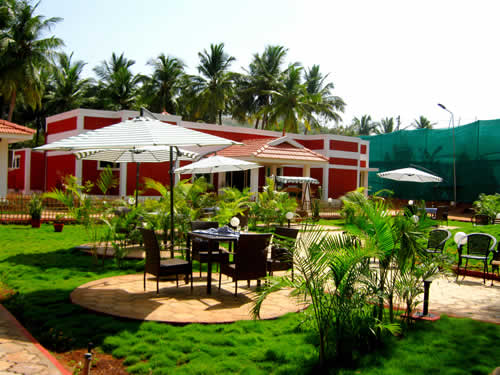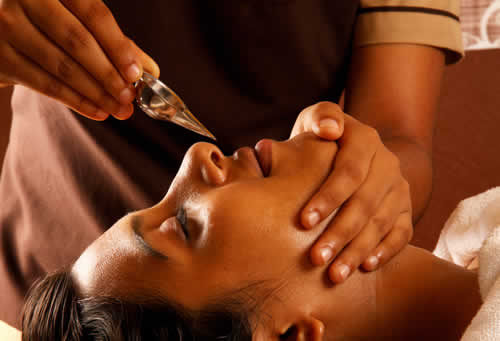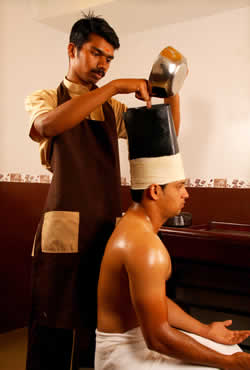Positive Health Online
Your Country

Ayurveda in Action in South India
listed in ayurveda, originally published in issue 205 - April 2013
On first appearance Arogya, looks more like a Taj-style holiday resort than an Ayurvedic hospital. It is a serene scattering of Kerala-style red tiled buildings amidst lush foliage, palm trees and manicured lawns. Ensconced in fifteen acres of tranquil grounds, Arogya Ayurvedic Hospital is just a 7km drive from the heaving traffic and bustle of Madurai, in Tamil Nadu, South India.

Hospital cottages
Peace descends as you leave Madurai and Vilachery road quietens down as it winds out of town and into the sprawling premises of Arogya, overlooking the ancient Tiruparamkundram temple rock.
On the hospital veranda, people look out at the calm surroundings as they wait patiently to see their physicians. Nothing about the place is frenetic or hurried. A healing atmosphere could not be more perfect.
This is where 80 years of family practice has developed into one of the best Ayurvedic centres in the south, founded by Dr Raghava Varier, a consultant to many an Indian President in the past. From a one-man practice, it has expanded with centres in other parts of India with the Varier descendants forging ahead, adapting this ancient system of medicine in a very modern environment. This includes integrating allopathy when required.
Therapeutic Structure
At Arogya Ayurvedic hospital, preventative and curative treatments are offered with a good degree of success. Over 80% of infertility cases have been successfully treated with women going on to conceive. Positive results also prevail within the neurological, bone and joint, paediatric and wellbeing areas.

Nasal medication
Talking about the concepts of health and disease in Ayurveda, Dr Ramesh Varier, Managing Director and son of Dr Raghava Varier, explains that diet and lifestyle have a huge impact on health.
“Here we look at the individuals and the need to tune their diet and lifestyle according to their constitutions. We talk about how we align the body clock and for instance, suggest Nasyam, where oil is instilled in the nostril. This keeps the organs healthy, slows down degeneration and strengthens the nervous system,” said Dr Varier.
“Accumulation of toxicity, ama, is the major cause of ill health. Ama is generated in the body. If your digestive process does not function well it leads to ama which is also the natural by-product of metabolism. It becomes relevant when this is not eliminated.”
Dinachariya
Ayurveda is based on the principle of three doshas - Vata, Pita and Kapha. These are energies or bodily humours that make up an individual and are responsible for the different physiological functions in the body. We all have these doshas in various degrees, but with one or two doshas dominating. An imbalance in the tridoshas is said to contribute to ill health and disease.
Arogya recommends the daily Ayurvedic regimen, Dinachariya, to maintain a person’s biorhythms in keeping with the environment. This includes Anjanam, where a herbal decoction is applied to the eyes for bright eyes and clear vision. Kabalam is where a gargle with oil is recommended for mouth disorders; or Dhuman , a half hour treatment where the client inhales the smoke of herbs, particularly good for upper respiratory ailments.
Other aspects of Dinachariya include massaging the whole body with oil, Madanam, followed by exercise, Vyayam and then a bath, Snanam.
“A bath at the end of a stressful day stimulates the para sympathetic nerves. It promotes sleep,” says Dr Varier.
For longevity, Dr Varier recommends waking up well before sun rise. Waking up early at Brahma Murata (an auspicious time for waking up) means one benefits from the ozone which is at its maximum. Dinner after sunset and an early night are all said to maximize physical, mental and spiritual health.
Preventative and Curative Treatments
Samanam
Clients at Arogya seeking general health maintenance are offered a series of tailor made therapies. Samanam corrects abnormalities in the system such as problems with digestion or bowels.
“This is the most pacifying of therapies. However, here you are not addressing the root cause of the disease and hence there is a high chance of recurrence,” says Dr Varier.

Sirovasthi - Oil stagnation
Sodhanam
Ama exits in three stages, says Dr Varier. Where clients display mild toxicity this is easily eliminated through a protocol of rest and light food. Clients at this level display minor imbalances such as sluggishness, heaviness, headaches and lack of energy. Fasting, and advice on lifestyle changes, are suggested to further enhance the healing process.
Where ama is of moderate intensity, clients are given herbal decoctions that help with the elimination of toxins through Paachanam, a digestive therapy which also facilitates metabolism.
Where there is very high level of toxicity as in the case of chronic diseases, the hospital resorts to Panchkarma, the five modalities of detoxification which can take three to seven days.
Typically, a detox programme starts with patients consuming lipids, oils, or ghee. In Ayurveda, ghee is regarded as the best form of food utilized by the body. Patients start on 50ml of ghee and this is increased up to 300ml based on the person’s sensitivity levels. When a person is saturated with ghee, the eliminative process is initiated.
The very high doses of ghee serve to mobilize the toxins by stimulating the LXR (regulator of cholesterol and fatty acids) and nuclear receptors. This results in an increased synthesis of bile acids. The re-absorption of bile acids by the large intestine is prevented. Toxins accumulated in all parts of the body are brought to the liver for metabolism through Swethnam, or induced sweating through steam baths.
Patients at this stage are fed with rice porridge alone while their bodies go through the enormous task of mobilizing and releasing toxins. Patients with excess kapha prone to much mucus and upper respiratory problems or skin diseases undertake Vamana or medically induced vomiting. Psoriasis is seen as a disease of excess vata and kapha.
Vamana is followed by virechana or purgation where toxins are eliminated in the stool.
Enemas or Vasti form an important part of panchakarma. They are particularly useful for addressing neurological and endocrine disorders as a result of excess vata.
“In autoimmune diseases, we give a series of vamana and vasti and this brings down the levels of inflammation. For instance, in a case of ESR level of 120, we can bring it down to 30 within fifteen days,” said Dr Varier.
Elimination results in increased vata energy and this needs to be pacified. This is done through Nasya, nasal therapy and sneha vasti where the patient is treated to light food, oil massage and baths before a vasti. Rakta mokshana, blood letting, is called for when there are high levels of toxicity in the body. Rakta mokshana is undertaken through a venous section or leeches. This therapy shows dramatic improvement in inflammatory conditions like eczema and rheumatoid arthritis.
Chronic Diseases
Dr Varier says that when it comes to chronic diseases, like cancer, Ayurveda looks to stronger substances to treat them.
“Samanam is good in acute conditions where you have to bring it under control. Allopathy also comes under this category but it is not the best solution. Many problems can be treated just through changes in lifestyle and diet . When it gets beyond a certain level then we have to use more powerful means of treatment.”
“We use poison to deal with severe forms of diseases with levels of intervention proportionate to the problem.”
If safer options are offered by Allopathy, then Arogya uses these. “The two systems can be integrated at the right time and place.”
Cancers are a result of intrinsic irritation or imbalances where the immune system is depressed for various reasons such as toxicity and chronic mental and physical stress leading to the over production of hormones. In a continuously stressed immune system, toxins modify the DNA to create monster cells. A robust immune system reduces the risk of cancer, says Dr Varier.
In cases of hormonal imbalance, Aryoga treats patients with non hormonal herbal medicines such as Sukumaram Kashayam. It is useful to block overproduction of oestrogen and hence used in breast cancer treatments. It also plays a major role in male and female infertility treatments.
15% of women visiting the hospital suffer from menstrual problems and 15% of married couples are infertile. Dr Varier claims that the increase in disorders such as fibroids, amenorrhea and polycystic ovaries are related to the contemporary problems of sedentary lifestyle, junk food and high levels of stress.
While these problems are successfully treated, non compliance by patients contribute to the failures in treatment.
Rasayanam
All treatments are concluded with Rasayanam. Chronic diseases deplete the system, damaging tissue. Rasayanam is a tissue repair therapy which aid to prevent and reverse damage to the body. Powerful anti-oxidant tonics and medicines, general as well as disease-specific, are prescribed to patients. Dr Varier says that everyone would benefit from a teaspoon of Triphala at night.
Triphala is one of the most popular herbs in Ayurveda and is recommended for its wealth of healing powers: for longevity, weight loss, digestion, detox and vitality. As a holistic medical system, Ayurveda also prescribes yoga and meditation as part of a wellbeing programme.
Further Information
For more info on Argoya contact: www.avnarogya.in www.avnswasthy.com
Comments:
-
Nisha Agarwal said..
Yes, Ayurveda Treatment in South India, works at the best phase for any chronic disease.. Complete natural healthcare treatment that makes effective and temporary solution for all your problems... Buy your skincare and chronic problems like Asthma, PCOS/PCOD etc medicines and treatment solutions from professionals clinic.. Jammi an advanced ayurveda wellness clinic in India!!!
https://jammi.in/